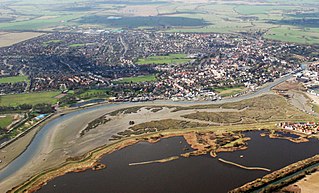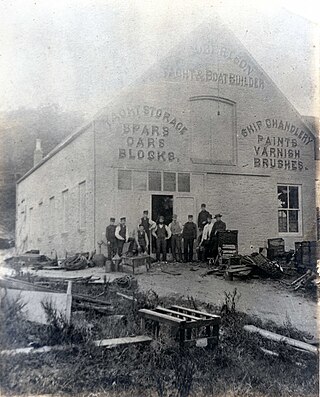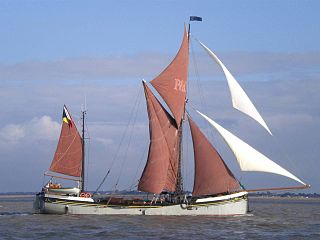
The Chelmer and Blackwater Navigation is the canalisation of the Rivers Chelmer and Blackwater in Essex, in the east of England. The navigation runs for 13.75 miles (22.13 km) from Springfield Basin in Chelmsford to the sea lock at Heybridge Basin near Maldon. Initial plans faced spirited opposition from Maldon, which were overcome by avoiding the town and terminating at Heybridge, and the navigation opened in 1797. There were some teething problems, and the engineer John Rennie was called back on two occasions to recommend improvements. The impact of the railways was less severe than on many canals, as there was never a direct line between Chelmsford and Maldon. The sea lock at Heybridge was enlarged after the Second World War, but trade gradually declined and ceased in 1972.

Maldon is a town and civil parish on the Blackwater estuary in Essex, England. It is the seat of the Maldon District and starting point of the Chelmer and Blackwater Navigation. It is known for Maldon Sea Salt which is produced in the area.
This glossary of nautical terms is an alphabetical listing of terms and expressions connected with ships, shipping, seamanship and navigation on water. Some remain current, while many date from the 17th to 19th centuries. The word nautical derives from the Latin nauticus, from Greek nautikos, from nautēs: "sailor", from naus: "ship".

A Thames sailing barge is a type of commercial sailing boat once common on the River Thames in London. The flat-bottomed barges, with a shallow draught and leeboards, were perfectly adapted to the Thames Estuary, with its shallow waters and narrow tributary rivers. The larger barges were seaworthy vessels, and were the largest sailing vessel to be handled by just two men. The average size was about 120 tons and they carried 4,200 square feet (390 m2) of canvas sail in six working sails. The mainsail was loose-footed and set up with a sprit, and was brailed to the mast when not needed. It is sheeted to a horse, as is the foresail; they require no attention when tacking. The foresail is often held back by the mate to help the vessel come about more swiftly.

The spritsail is a four-sided, fore-and-aft sail that is supported at its highest points by the mast and a diagonally running spar known as the sprit. The foot of the sail can be stretched by a boom or held loose-footed just by its sheets. A spritsail has four corners: the throat, peak, clew, and tack. The Spritsail can also be used to describe a rig that uses a spritsail.

The United States Coast Guard Yard or just Coast Guard Yard is a United States Coast Guard operated shipyard located on Curtis Bay in northern Anne Arundel County, Maryland, just south of the Baltimore city limits. It is the largest industrial facility in the Department of Homeland Security. It falls under the Coast Guard's Engineering and Logistics Command. It is the Coast Guard's sole shipbuilding and major repair facility, and part of the Coast Guard's core industrial base and fleet support operations. Engineering, logistics, and maintenance responsibilities and complete life-cycle support; installation, operations, maintenance and ultimately replacement. Its annual budget is $88 million.

Alexander Robertson & Sons was a boatyard in Sandbank, Argyll and Bute, Scotland, from 1876 to 1980. The yard was located on the shore of the Holy Loch, not far from the Royal Clyde Yacht Club (RCYC) at Hunters Quay, in the building that is now the Royal Marine Hotel, which was the epicentre of early Clyde yachting. Alexander Robertson started repairing boats in a small workshop at Sandbank in 1876, and went on to become one of the foremost wooden boatbuilders on Scotland's River Clyde. The "golden years" of Robertson's yard were in the early 1900s, when it started building some of the first IYRU 12mR & 15mR racing yachts. Robertson's was well known for the quality of its workmanship and was chosen to build the first 15-metre yacht designed by William Fife III. More than 55 boats were built by Robertson's in preparation for the First World War and the yard remained busy even during the Great Depression in the 1930s as many wealthy businessmen developed a passion for yacht racing on the Clyde. During World War II the yard was devoted to Admiralty work, producing a wide range of large high-speed Fairmile Marine Motor Boats. After the war, the yard built the successful one-class Loch Longs and two 12-metre challengers for the America's Cup: Sceptre (1958) and Sovereign (1964). Due to difficult business conditions, the Robertson family sold the yard in 1965, and it was turned over to glass-reinforced plastic production work until it closed in 1980. During its 104-year history, Robertson's Yard built 482 numbered boats, many of which are still sailing today.

Thalatta is a Thames sailing barge, built in Harwich, Essex, in 1906 and rebuilt in St Osyth in 2012. She is 90 feet (27 m) long and 26 feet (7.9 m) across the widest part of the deck. Like all Thames barges, she is flat-bottomed and has leeboards instead of a keel. She spent some of her life ketch-rigged and some of it spritsail-rigged. She is now permanently spritsail rigged, and has a mainmast and topmast that, together, are about 90 feet (27 m) high, and a mizzen mast. Thalatta has had two periods with an auxiliary engine and two without. She carried cargo for sixty years and was then converted for use as a sail training ship in 1966. She was completely rebuilt between 2006 and 2012 at St Osyth with assistance from lottery funds.

Philip and Son was a shipbuilder in Kingswear, near Dartmouth, Devon, England. Operating from 1858 until the late 1990s, the company provided employment opportunities for nearly 141 years for many people of Dartmouth. It was Dartmouth's last industrial shipyard. A documentary film, Philip and Son, A Living Memory, presents the story of the industrial shipyard from its beginning to its eventual closure.

Lady of the Lea is a spritsail Thames sailing barge, the last such barge to be built in England. She was built in 1931 to carry explosives from Waltham Abbey Royal Gunpowder Mills on the River Lea to Woolwich Arsenal on the River Thames. The barge was later sold and rebuilt. She currently operates as a private yacht and competes in Thames sailing barge matches.

Will is a Thames sailing barge, built in Great Yarmouth by Fellows & Co in 1925. She is 97.6 ft (29.75 m) long, 23.1 ft (7.04 m) across and 9.6 ft (2.93 m) deep. Will Everard, as she was originally known, was commissioned as one of four steel barges; the largest ever built. She is a mulie, with a spritsail rigged mainmast, a topmast and a gaff-rigged mizzen. She has a flat bottom with leeboards as is customary for Thames sailing barges. As one of the last sailing cargo vessels to operate in UK waters she left trade in 1966. After a few years lying derelict, she was refitted and eventually entered into the service of P&O where she was used as a floating board room until 1999. This role in corporate hospitality continued and she now is fully engaged in private charter work. She currently operates out of the Pool of London from a base at Hermitage Community Moorings, Reeds Wharf and St Katherine Docks for cruises through London, the east coast and beyond.

Francis Charles Morgan-Giles was a boat designer and builder from Devon, England. He built rowing boats, dinghies, yachts and large motor cruisers. His boats were known for their high quality, elegance and craftsmanship.

SB Centaur is a wooden Thames sailing barge, built in Harwich, Essex, England in 1895. She was used to carry various cargoes, mainly grain, for the next 60 years. During the First World War she carried food and coal to the French Channel ports. During the Second World War Centaur was damaged when sailing to assist with the Dunkirk Evacuation. She did war work for the duration of the conflict.

The SB Kathleen was a spritsail Thames barge built by Glover at Gravesend, Kent, in England in 1901, and registered in Rochester. Her official number was 113,708. She was built to carry grain- for capacity rather than speed. she was 82.8 feet (25.2 m) long and had a beam of 19.7 feet (6.0 m). Light, she drew 30 inches (76 cm) of water, and laden 6 feet (1.8 m).

SB Decima is a steel Thames sailing barge constructed in Southampton in 1899 by J.G. Fay and Co, Southampton for E. J. Goldsmith of Grays, Essex. She is back under sail and resident on the River Darent in Dartford, Kent. She is a notable "Historic Ship".

Mirosa is a Thames barge which was built in 1892. From 1892 until 1947, she sailed under the name Ready when the name was sold to Trinity House for a lightship support vessel. Under her new name, she traded until 1955. Mirosa has never had an engine.

George Smeed is a Thames barge built in 1882 by Smeed Dean & Co. Ltd. in Murston.
Herbert Woods was an English boat builder and mooring developer from Potter Heigham, Norfolk.
This glossary of nautical terms is an alphabetical listing of terms and expressions connected with ships, shipping, seamanship and navigation on water. Some remain current, while many date from the 17th to 19th centuries. The word nautical derives from the Latin nauticus, from Greek nautikos, from nautēs: "sailor", from naus: "ship".
Camper and Nicholson was a yacht design and manufacturing company based in Gosport, England, for over two hundred years, constructing many significant vessels, such as Gipsy Moth IV and Prince Philip's yacht Bloodhound. Its customers included Thomas Sopwith, William Kissam Vanderbilt II and George Spencer-Churchill, 6th Duke of Marlborough. Its yachts competed in The America's Cup, The Fastnet Race, the Olympics, the Ocean Race and many other yacht races.
















